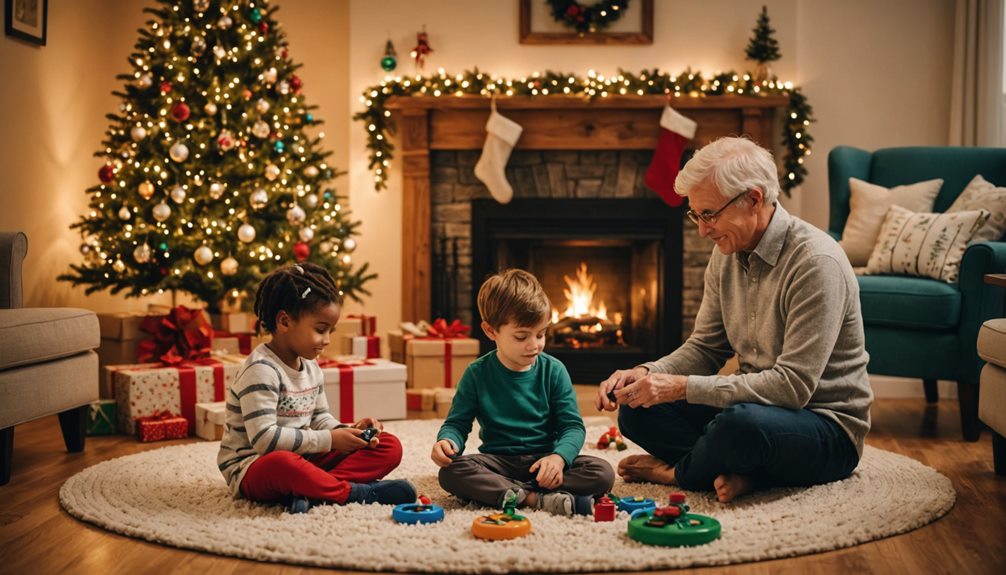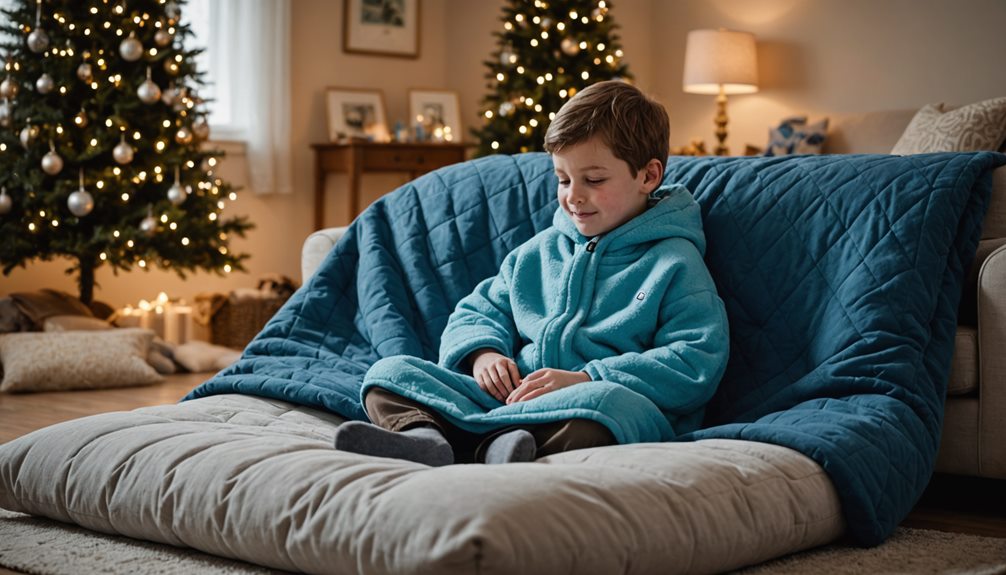The holiday season is a magical time, but for children with sensory sensitivities or autism, it can also be overwhelming. Bright lights, loud sounds, unfamiliar foods, and changes in routines can make it hard for them to feel comfortable and enjoy the festivities. As a pediatric therapist, I know how important it is for families to approach this season with care. With thoughtful, sensory-friendly holiday strategies, you can help your child feel more at ease and fully participate in the celebrations.
From holiday shopping to family gatherings, every part of the season can pose challenges. Crowded stores, noisy environments, and new faces may lead to sensory overload. Planning can make a big difference. Choose quieter times for errands, create a visual schedule for your child, and prepare them for what to expect. Small steps like these are essential sensory-friendly holiday strategies that can reduce anxiety and help your child feel safe.
Remember, the holidays don’t have to be perfect—they need to work for your family. Focus on moments of connection, not perfection. If your child needs breaks during a celebration or prefers familiar foods, that’s okay. By meeting their needs with love and understanding, you’re giving them the best gift of all: a joyful, stress-free holiday season filled with memories to cherish.
Key Takeaways
- Incorporate sensory-friendly strategies in holiday preparations, like subtle decorations and calm retreat spaces, to avoid sensory overload.
- Establish evident, inclusive family traditions and gradually involve children with autism in home embellishments to foster communication.
- Equip children with coping mechanisms for social interactions during gatherings and make changes in routine more predictable with the help of calendars or social stories.
- Prioritize sensory-sensitive and educational gifts and communicate the child’s needs and preferences to family members to set realistic expectations.
- Parents should prioritize self-care and seek support from family, friends, or professionals to sustain energy and mental well-being during the festive season.
Holiday Preparation Strategies
Recognizing the specific needs of children with autism, thoughtful holiday preparation strategies can be implemented to ensure a joyful, inclusive season. Fostering an environment that respects sensory needs, such as creating calm spaces and using structured tactile activities, encourages participation and can go a long way in creating a sense of belonging and excitement for your child.
Consider establishing new family traditions that are inclusive and enjoyable for your child. Simple activities such as a low-key holiday film night or crafting homemade decorations can generate anticipation and a sense of ownership in the festivities. Tailoring the environment to improve comfort, which can be achieved by gradually introducing holiday decorations, thus avoiding any overwhelming experiences, is also beneficial.
Utilize calendars and social stories to prepare your child for upcoming events and changes in routine. This will help promote a smooth shift and prevent sensory overload caused by sudden alterations.
Involving your child in the gradual embellishment of your home can also be beneficial. This encourages their participation while ensuring a comfortable and enjoyable holiday experience.
Another vital strategy is setting realistic expectations around gift-giving. Limiting present fixations helps manage expectations and prevent overwhelming feelings during the holiday season. With these thoughtful preparation strategies, your holiday can be a celebration of love, joy, and inclusivity, catering to your child’s distinct needs.
Managing Decorations Effectively
Exploring the world of holiday decorations can be an enriching experience for children with autism when managed effectively. Early involvement in selecting decorations can help foster communication skills, often a challenge in children with autism, and provide a sense of engagement. Clear rules for touching decorations should be established to maintain boundaries and prevent sensory overload.
Bright colors and loud noises connected to holiday decorations may lead to sensory overload, a common sensory sensitivity in autistic children. Considering this aspect while decorating helps create a more calming environment for children with autism. Subtle, less flashy decorations can be just as festive without causing unnecessary stress.
Creating a safe space amidst decorations provides a retreat from overwhelming stimuli. This space can offer a sense of security, promoting a positive association with the holiday environment. Gradual decoration is advised to allow children to adjust to the changes in their environment, which is in line with their typical developmental trajectory. By slowly introducing new elements, you can monitor your child’s reactions and make necessary adjustments.
Managing holiday decorations effectively is vital for children with autism. It helps prevent sensory overload, allows adjustment time, and provides a safe space, ensuring a more comfortable holiday experience.
Navigating Visits and Gatherings

Social events and visits can be challenging for children with autism, often leading to sensory overload or anxiety. By utilizing individualized interventions and strategies like simplifying social interactions into understandable segments, we can better manage visitor interactions and establish safe spaces. In addition, encouraging shared interests and activities during these gatherings can aid in bridging communication gaps. Parents and caregivers can additionally support children in these settings and help them thrive. These strategies can equip the child with coping mechanisms and provide comfort, ensuring they have a positive experience during these gatherings.
Managing Visitor Interactions
A thoughtfully crafted approach can make a noteworthy difference in managing visitor interactions for children with autism. Holidays often bring a flurry of activity that can be overwhelming, but with the right strategies in place, these situations can be navigated effectively. Pediatric occupational therapists usually emphasize the importance of preparing children for changes in their routines, especially during events such as holiday gatherings. This involves making them aware of new faces they might encounter, alterations in their usual schedule, and potential sensory challenges they might face.
- Social Stories and Visual Aids: Prepare for visits by discussing upcoming guests using social stories and visual aids. Introducing children to the concept of holiday gatherings and the people they will meet can distinctly reduce their anxiety. A photo album of visiting friends and family can familiarize your child with who they’ll be seeing, reducing uncertainty and setting clear expectations.
- Calming Area and Private Space: During gatherings, designate a calming area and a private space for your child. These spaces offer a retreat from overwhelming situations and give your child control over their environment, promoting a sense of security.
- Teaching Tools for Management: Equip your child with tools to manage social interactions effectively. This could involve teaching them signals or phrases to communicate their comfort levels or strategies to exit overwhelming situations calmly. Pediatric occupational therapists often work with children to develop these communication skills.
Establishing Safe Spaces
Designating a calming area or safe zone in your home regularly is a considerate method that can significantly assist children with autism in managing sensory overload during visits or gatherings. This safe zone should be a private and tranquil retreat furnished with comforting items like headphones, preferred toys, or soothing activities.
As caregivers, it’s essential to teach our kids how to communicate their needs when feeling overwhelmed by visitors or social interactions. Visual cues or signals can be highly beneficial in this process. They can help the child recognize when they need to pause and withdraw to their safe area.
It’s also vital to reinforce to family and guests the necessity to respect your child’s boundaries. This guarantees a stress-free environment for the child and allows them to handle their sensory experiences better.
Here’s a quick guide:
| Key Aspect | Details |
|---|---|
| Safe Zone | Private, tranquil, furnished with comforting items |
| Communication | Teach how to express the need for a pause |
| Visual Cues | Use signals to indicate when a withdrawal is needed |
| Respect Boundaries | Family and guests must honor the child’s safe zone |
| Stress-Free Environment | Ensuring the child feels secure and at ease |
Creating a safe zone is fundamental to helping children with autism thrive during holiday gatherings.
Holiday Travel Tips and Tricks
Steering through the bustling holiday season can often feel like piloting a ship through a storm, particularly when traveling with a child on the autism spectrum. Children with autism, especially boys, usually have more pronounced difficulties with changes and disruptions to their routine, such as those brought about by holiday travel. Holidays typically require travel, and for children with autism, this can present distinctive challenges.
Here are some tips and tricks to make the voyage smoother and more enjoyable for everyone involved:
- Preparation is key. Pack their favorite foods, books, or toys. This caters to their sensory preferences and provides a sense of familiarity amid the unknown. Girls with autism, in particular, may benefit from having familiar items around due to their tendency for social camouflaging.
- Use social stories to explain the holiday travel plans. Setting clear expectations can help demystify the travel process and reduce anxiety.
- Have contingency plans in place for unexpected delays. This can help maintain a sense of calm and control in potentially stressful situations.
Throughout the voyage, maintain clear communication about what’s happening next. This can be especially helpful in navigating airport processes or long car journeys. Remember, each child is unique, so it’s vital to tailor these strategies to your child’s specific needs. With thoughtful preparation and flexibility, holiday travel can become a more manageable and even enjoyable experience.
Gift Giving Considerations

Maneuvering the intricacies of gift-giving for a child with autism can be a delicate task that requires thoughtful consideration. Incorporating their preferences and sensitivities into gift selection can make the process more enjoyable for the child and the giver. Sensory-friendly gifts, interactive or educational toys that cater to their specific interests and needs, are worth prioritizing.
Communicating with family members about your child’s needs, interests, and distinct preferences is imperative. Providing them with suggestions for suitable gifts can guide their choices and make family interactions more comfortable during the holidays.
Consider the following table to help visualize preferred gift options and potential family interactions:
| Preferred Gifts | Family Interactions |
|---|---|
| Sensory-sensitive toys | Play interactive games |
| Books related to interest | Read together |
| Art supplies | Artistic family activity |
| Puzzles | Problem-solving together |
| Educational games | Learning new skills together |
Setting Expectations and Embracing Flexibility
When guiding through the holiday season with a child with autism, it’s crucial to base expectations on actuality and welcome the unforeseeable. This method aids in reducing stress, allows for adjusting to unforeseen circumstances, and promotes a more pleasant experience for both parent and child. Let’s delve into how releasing the pursuit of flawlessness and embracing uncertainty can result in a calmer and more cheerful holiday season.
Grounding in Realism
Infused with the spirit of the holiday season, it’s essential to ground ourselves in genuineness, set achievable expectations, and embrace adaptability. This approach not only helps create a stress-free holiday for children with autism but also promotes a more relaxed atmosphere for the entire family. Understanding the sensory needs of these children and accepting that perfection is not attainable can significantly reduce the pressure and make the holiday time more enjoyable.
The following are three key strategies to keep in mind:
- Set Authentic Expectations: It’s vital to be realistic. Don’t aim for a picture-perfect holiday. Instead, plan for what will suit your child’s needs best during this time.
- Embrace Adaptability: Holidays are unforeseeable. Being flexible and open to changes can help you navigate unexpected situations, ensuring a smoother and harmonious holiday season.
- Create a Sensory-Friendly Environment: Understand your child’s sensory needs and create an environment that is comfortable for them. This can help reduce their anxiety and promote a calm atmosphere.
Embracing Holiday Unpredictability
In the midst of holiday festivities, unpredictability often becomes the only foreseeable element. Embracing this unpredictability, especially for families of children with autism, requires a delicate balance of setting expectations and embracing adaptability.
Setting expectations is a crucial part of holiday planning. This reduces stress and anxiety by creating a clear path for the holiday season. However, these expectations must be realistic, understanding that plans may change due to unforeseen events. Flexibility is key in navigating these adjustments.
Embracing adaptability rather than resisting it can alleviate pressure and lead to a more relaxed and harmonious atmosphere. This understanding can be especially beneficial for children with autism, who may find the chaos of holidays overwhelming.
Prioritizing Emotional Well-being

Exploring the emotional landscape of children with autism, particularly during the holiday season, demands both awareness and sensitivity. Giving precedence to their emotional well-being can significantly decrease stress and anxiety levels and create an environment that nurtures joy and tranquility.
- Creating moments of seclusion: Carve out designated quiet times during the holiday rush. These moments can offer children with autism the space to process emotions, contributing to their overall feeling of well-being.
- Prioritizing rest: Rest is essential for emotional regulation. Ensure a consistent sleep schedule is maintained during the holiday season—this benefits both the child and caregiver.
- Establishing boundaries: Setting boundaries is crucial to safeguarding mental and emotional health. This could involve limiting holiday activities that may overwhelm or cause distress.
Furthermore, practicing self-kindness and making self-care a priority is not just advantageous but indispensable. They aid in replenishing emotional resources, making it more straightforward to navigate the demands of the holiday season. Keep in mind that a caregiver’s well-being directly impacts the child’s emotional health. By incorporating these strategies, we can cultivate a more harmonious, stress-free holiday experience for children with autism.
Building Supportive Holiday Traditions
Cultivating supportive holiday customs is a proactive stance that can offer comfort, predictability, and a sense of security for children with autism. These customs, tailored to meet your child’s distinct needs, can be an effective tool to manage stress and anxiety during the fast-paced holiday season.
Creating rituals within your family can offer moments of calm and respite amid the hustle and bustle of holiday preparations. These special activities, designed to provide a break from seasonal demands, can help maintain your child’s emotional well-being and stability. They can be as simple or elaborate as needed, but consistency and predictability are critical.
Meaningful customs foster a sense of connection and belonging. This sense of inclusion contributes to a joyous holiday experience, providing a unique touchpoint for children with autism. These customs, built around the child’s interests and abilities, not only affirm their value but also reinforce their sense of security and belonging.
Self-Care Practices for Parents

The holiday season is magical, but it can be overwhelming for children with sensory sensitivities or autism and equally challenging for the parents and caregivers supporting them. Bright lights, loud sounds, unfamiliar routines, and busy schedules can add stress to your child, which naturally increases your stress. As a pediatric therapist, I want to remind you that taking care of yourself is just as important as helping your child. Thoughtful, sensory-friendly holiday strategies can ease the season for everyone in the family.
The extra demands of the holidays, from crowded stores to large gatherings, can leave you feeling drained. Planning quieter shopping times, preparing your child for celebrations, or finding moments for sensory breaks are all important. But it’s also essential to build in time to recharge yourself. Including self-care as part of your sensory-friendly holiday strategies helps you stay calm and present, which makes it easier to support your child.
Remember, the holidays are about connection, not perfection. Let go of unnecessary pressures and focus on what works best for your family. If you need to say no to specific events or ask for help, do so without guilt. When you care for yourself, you’re better equipped to create a joyful, stress-free holiday season for your child—and yourself.
Self-care is not an indulgence but a necessity. It allows parents to replenish their emotional reserves, enabling them to support their children with autism better. Here are three self-care practices that can be beneficial:
- Prioritize Sleep: Adequate sleep is vital for your physical health and mental stability. Make it a non-negotiable part of your routine.
- Set Boundaries: Learn to say ‘no’ when needed. This will help you manage your stress levels and maintain a healthy balance.
- Engage in Rejuvenating Activities: Pursue activities that you enjoy and refresh your spirit. This could include reading, meditating, or simply spending time in nature.
Furthermore, building a solid support system is invaluable. Connecting with other parents who understand your path can provide emotional comfort and practical advice.
Frequently Asked Questions
What Are Some Autism-Friendly Holiday Destinations Worth Considering?
Consider destinations with sensory-friendly environments, such as quiet nature reserves, visually stimulating aquariums, or theme parks offering accessibility programs. Also, prioritize places with flexible schedules to accommodate potential changes in your child’s routine or mood.
How Can I Use DIR/Floortime Strategies During Holiday Festivities?
Using DIR/Floortime strategies during holiday festivities means focusing on connection, flexibility, and emotional regulation. Follow your child’s lead to create moments of joy, whether it’s engaging in sensory-friendly activities or exploring holiday traditions at their pace. By staying attuned to their needs and supporting them through co-regulation, you can turn holiday challenges into meaningful opportunities for bonding and growth.
What Are Sensory-Friendly Decoration Ideas for Children With Autism?
Sensory-friendly decorations for children with autism could involve soft lighting, minimal flashing lights, and non-glittery ornaments. Avoiding overstimulating colors and focusing on tactile-friendly items can create a calming and enjoyable atmosphere for the child.
How Can Food Choices During Holidays Affect a Child With Autism?
Food choices have a profound impact on children with autism. Familiar, routine foods can create a comforting environment. However, new or altered menu items can prove a double-edged sword, potentially causing distress or triggering sensitivities.
Are There Specific Holiday-Themed Activities That Can Help Improve Social Skills in Autistic Children?
Yes, specific holiday-themed activities can boost social skills in autistic children. For instance, group crafts, role-playing holiday scenarios, or themed games can encourage interaction, cooperation, and communication, thereby improving their social prowess.
Conclusion
In sum, successful holidays for children with autism hinge upon careful preparation, flexible strategies, and empathetic understanding. By handling sensory cues in decorations, meticulously organizing visits, travels, and gifts, keeping an open mind about expectations, and prioritizing mental well-being, an environment conducive to joy and participation is created. The integration of inclusive customs, combined with essential self-care practices for parents, further bolsters these efforts. Therefore, a harmonious holiday experience centered on the specific needs of these children is not only possible but completely achievable.


Recent Comments